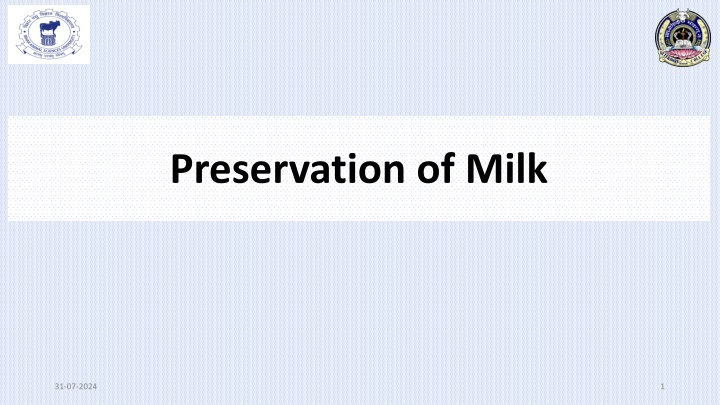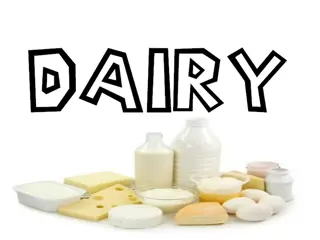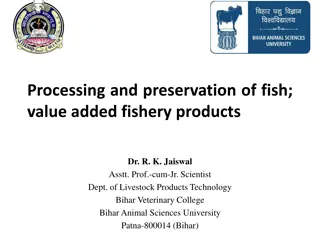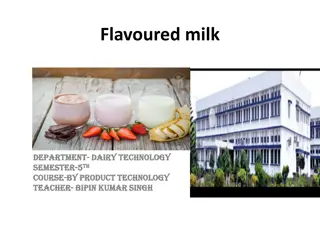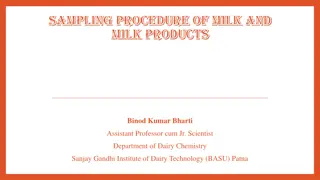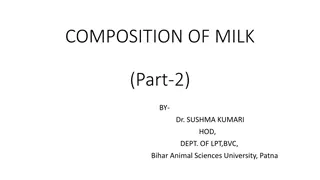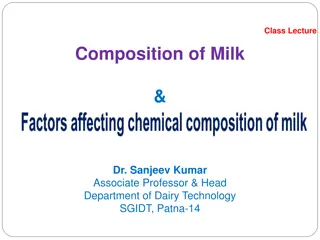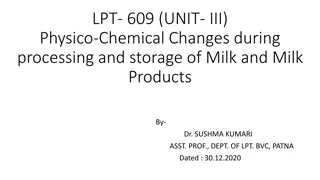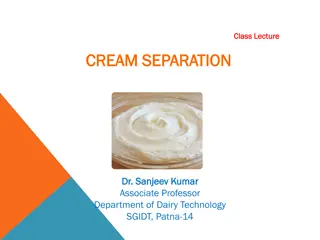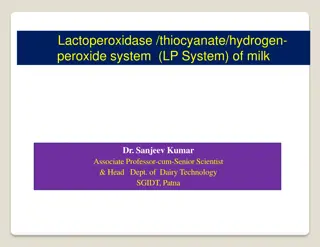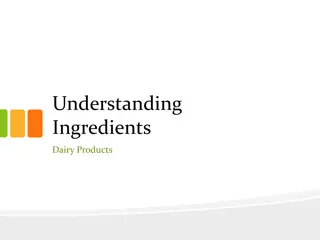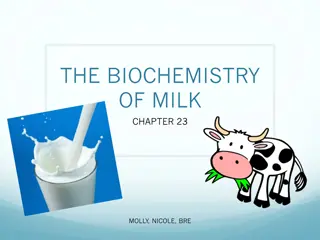Milk Preservation Techniques and Methods
Milk can be preserved using various techniques such as chilling, pasteurization, and chemical preservation methods like hydrogen peroxide. The shelf life of milk can be extended by cooling or utilizing the lactoperoxidase system. Germicidal properties of fresh milk and naturally occurring inhibitory substances also play a role in milk preservation.
Download Presentation

Please find below an Image/Link to download the presentation.
The content on the website is provided AS IS for your information and personal use only. It may not be sold, licensed, or shared on other websites without obtaining consent from the author.If you encounter any issues during the download, it is possible that the publisher has removed the file from their server.
You are allowed to download the files provided on this website for personal or commercial use, subject to the condition that they are used lawfully. All files are the property of their respective owners.
The content on the website is provided AS IS for your information and personal use only. It may not be sold, licensed, or shared on other websites without obtaining consent from the author.
E N D
Presentation Transcript
Preservation of Milk 31-07-2024 1
Preservation of milk Preservation of milk At room temperature milk can be stored only for 3 hr immediately after milking. The shelf life of milk can be extended to 24 hr, by cooling to 50C. Its shelf life is further extended to 4 to 7 days need equipment and electricity, Whereas by use of lactoperoxidase system milk can be preserved for 6-12 hr, without the need for equipment and electricity. 31-07-2024 2
Preservation of milk by chilling Preservation of milk by chilling Chilling of milk to 50C or below for 24 hr and holding it at such a temperature will preserve the milk by preventing the multiplication of microorganisms but it does not destroy them as in pasteurization. 31-07-2024 3
Pasteurization Pasteurization Batch pasteurization / low temperature long time pasteurization (LTLT) High temperature short time pasteurization (HTST) Ultra high temperature treatment (UHT) 31-07-2024 4
Preservation of milk Preservation of milk Chemical methods Milk can be preserved by addition of preservation such as hydrogen peroxide (H2O2) and lacto peroxidase system along with chilling. The preservative and bacteriostatic effect is due to the nascent oxygen released on oxidation of H2O2 by the enzyme catalase, as well as the H2O2 itself acts as a bacteriostatic agent. The permissible limits recommended by FAO (1957) for the use of H2O2 in milk is less than 800 ppm. However, the use of H2O2 is not permitted by Prevention of food Adulteration Act (PFA, 1954) because the flavour, body and marginal loss in biological value of made from treated milk are unsatisfactory. Besides, the marginal loss in biological value of proteins especially the sulphur containing amino acids in H2O2 treated milk is also observed. 31-07-2024 5
Germicidal period. Fresh milk exhibits germicidal properties for some period during which the growth of bacteria is either inhibited or decreased. This is called as germicidal period. This period varies considerably in length, usually shorter at higher temperatures and more prolonged at lower temperatures. It varies with the milk obtained from different animals, at different times, and also milk drawn from different quarters of udder. This germicidal activity is destroyed by heating milk to 60-80 C for 30 min. 31-07-2024 6
Naturally occurring inhibitory substances in milk. Naturally occurring inhibitory substances in milk. A variety of naturally occurring inhibitory or antimicrobial substances are secreted in milk. These substances help in the prevention of mammary gland infection or for providing passive immunity to the new born. Some of the substance also help in preserving milk (for some time) in natural form. One of the natural antimicrobial systems that has been thoroughly investigated as a possible preservative extending the shelf-life of raw milk is lactoperoxidase (LP) system. 31-07-2024 7
Lacto peroxidase/thiocyanate/hydrogen peroxide Lacto peroxidase/thiocyanate/hydrogen peroxide (LP) System (LP) System: : The three essential components of LP system are lacto peroxidase (enzyme), thiocyanate (substrate) and hydrogen peroxide (promoter). If any one of these is absent, the LP- system fails to get activated in milk and does not exhibit its antibacterial activity. International Dairy Federation (1988) recommended the use of LP-system for temporary preservation of raw milk during collection and transportation to the processing plant. They have recommended the addition of thiocyanate (14mg) and sodium percarbonate (30mg) per litre of milk within 3hr of its production. 31-07-2024 8
Lacto peroxidase is normally synthesized within the mammary gland and is always present in bovine milk (30ug/ml) but is absent in the human milk. The level needed for the LP- System to get activated in milk is 0.5-1.0 ug/ ml. Thiocyanate is the substrate for this enzyme to act and is present in varying concentration of 1 to 10 ppm depending on the feeding of the animal. The third component of the system, hydrogen peroxide, may be supplied by the organisms within the udder (e.g. streptococci) or by the PMN. Sodium thiocyanate and hydrogen peroxide when added @ 30:30mg/litre improves the keeping quality of milk to 10 hr at 370C. 31-07-2024 9
When all the three components are available, the system gets activated and produces unstable substances which are bacteriostatic. SCN + H2O2 Lactoperoxidase HOSCN + OH (Sulphacyanides) HOSCN (Hypothiocynouse acid) Dissociate OSCN (Hypothiocyanate ions) The hypothiocynate ions adversely affect the cell membrane causing inactivation of several vital metabolic enzymes, and leakage of potassium ions and amino acids. When H2O2 is available, the reaction proceeds further as under: HOSCN + H2O2 -----------> HO2SCN + H2O (Cyanosulphurous acid) HO2SCN + H2O2 -----------> HO3SCN + H2O (Cyanosulphuric acid) The ionic forms of above compounds possess bactericidal activity. 31-07-2024 10
The unstable oxidation product formed due to oxidation of SCN (Sulphacyanides) in the presence of H2O2 is bactericidal to enteric pathogens including multiple antibiotic resistant strains of E.coli and K. aerogenes. The inhibitory substance may be sulphurdicyanides,cyanosulfurous acid or cyanosulfuric acid, and hypothiocyanate ion was found as the active agent. Antimicrobial agents of LP-system in milk cause inhibition of various spoilage and pathogenic organisms, thus enhancing the microbiological quality of milk. LP system is bactericidal to gram negative organisms and bacteriostatic to gram positive organisms. The difference in the behaviour of gram positive and gram negative bacteria towards LP-system could be attributed to the structure and composition of the wall of gram positive and outer membrane of gram negative organisms respectively. 31-07-2024 11
Both specific and non-specific types of antimicrobial substances secreted in milk are:- Immunoglobulins: The immunoglobulins (Ig) to potentially pathogenic bacteria are often present in milk. They may be produced locally within the udder (IgA) or transferred to milk from the circulation (IgG). The primary function of these antibodies is to protect the new born through passive transfer of immunity. The udder is protected from infection by strains of coliform bacteria which are susceptible to complement/ antibody killing by the complementary body system. Antibody may also serve to reduce the severity of udder disease by neutralizing the toxins or by acting as opsonins to facilitate the phagocytosis of bacteria by polymorphonuclear leucocytes (PMN). They may also serve to prevent adhesion of bacteria to mucosal surface. 31-07-2024 12
Leucocytes / phagocytes. It is generally accepted that protection of the udder from mastitis rests primarily on the efficiency of phagocytosis and the destruction of invading bacteria by PMN. The total cell count of milk obtained from uninfected udders ranges from 1 to 5 lakh cells/ml, of which approximately 10% are PMN. Infected quarters may secrete milk containing 100 lakh cells/ ml of which 90% are PMN. Phagocytosis and killing by PMN is less effective in milk than in blood, largely because the PMN ingest large quantities of fat and casein. Increasing PMN content of milk has been shown to increase resistance of the udder to infection. 31-07-2024 13
Complement. About 9 components of complement are found to be present in human milk and they are associated with bacterial properties of milk. Bifidus factor. Bifidus factor is a nitrogen containing oligosaccharide present in the human milk, which supports the growth of Bifidobacteria in infants. Bifidobacteria helps in the maintenance of intestinal health. 31-07-2024 14
Lactoferrin. Lacroferrin (LF) is an iron binding protein similar to serum transferrin. Its concentration is markedly increased in the secretion of unmilked or infected animals. It inhibits the multiplication of bacteria by depriving them of iron and may protect the dry udder from infection with E.coli. Although LF is present in bovine milk, the high citrate and low bicarbonate concentration reduces the iron binding and, therefore, the inhibitory properties of LF. It has bacteriostatic activity against organisms like Staphylococcus aureus, S. albus, Pseudomonas aeruginosa and Vibrio cholerae. Lysozyme. Gram positive bacteria are sensitive to lytic action of lysozyme which is present in much higher concentration (approx. 30 mg/100 ml) in human milk than bovine milk (0.01 mg/100 ml). 31-07-2024 15
Miscellaneous substances. The other inhibitory substances found in milk include vitamin binding protein (for vit. B and folate), fatty acids and enzymes. Sometimes non inherent substances like antibiotics, pesticides or sanitizer can also be found in milk. 31-07-2024 16
